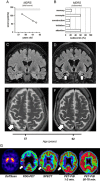Heterozygous Chorein Deficiency in Probable Tau-negative Early-onset Alzheimer Disease
- PMID: 26825611
- PMCID: PMC5035148
- DOI: 10.1097/WAD.0000000000000130
Heterozygous Chorein Deficiency in Probable Tau-negative Early-onset Alzheimer Disease
Abstract
Supplemental Digital Content is available in the text.
Conflict of interest statement
The authors declare no conflicts of interest.
Figures


Comment in
-
Heterozygous Deletion of Chorein Exons 70-73 and GNA14 Exons 3-7 in a Brazilian Patient Presenting With Probable Tau-Negative Early-Onset Alzheimer Disease.Alzheimer Dis Assoc Disord. 2017 Jan-Mar;31(1):82-85. doi: 10.1097/WAD.0000000000000185. Alzheimer Dis Assoc Disord. 2017. PMID: 28079535 No abstract available.
-
Chorein Deficiency and Alzheimer Disease: An Intriguing, Yet Premature Speculation.Alzheimer Dis Assoc Disord. 2017 Jan-Mar;31(1):80-81. doi: 10.1097/WAD.0000000000000186. Alzheimer Dis Assoc Disord. 2017. PMID: 28121633 Free PMC article. No abstract available.
References
-
- Klünemann HH, Fronhöfer W, Werner-Füchtenbusch D, et al. Characterization of the kindred of Alois Alzheimer’s patient with plaque-only dementia. Alzheimer Dis Assoc Disord. 2006;20:291–294. - PubMed
-
- Rampoldi L, Dobson-Stone C, Rubio JP, et al. A conserved sorting-associated protein is mutant in chorea-acanthocytosis. Nat Genet. 2001;28:119–120. - PubMed
-
- Hayashi T, Kishida M, Nishizawa Y, et al. Subcellular localization and putative role of VPS13A/chorein in dopaminergic neuronal cells. Biochem Biophys Res Commun. 2012;419:511–516. - PubMed
-
- Dobson-Stone C, Danek A, Rampoldi L, et al. Mutational spectrum of the CHAC gene in patients with chorea-acanthocytosis. Eur J Hum Genet. 2002;10:773–781. - PubMed
-
- Tomiyasu A, Nakamura M, Ichiba M, et al. Novel pathogenic mutations and copy number variations in the VPS13A gene in patients with chorea-acanthocytosis. Am J Med Genet B Neuropsychiatr Genet. 2011;156B:620–631. - PubMed
Publication types
MeSH terms
Substances
LinkOut - more resources
Full Text Sources
Other Literature Sources
Medical

